Biophysical Impacts of Land Use Change over North America as Simulated by the Canadian Regional Climate Model
Abstract
:1. Introduction
2. Model and Methods
2.1. The Canadian Regional Climate Model
2.2. Methodology
3. Results
3.1. Spatial Seasonal Analysis
3.2. Analysis of Average Annual Cycles
4. Discussion and Conclusions
Supplementary Materials
Acknowledgments
Author Contributions
Conflicts of Interest
References
- Mahmood, R.; Quintanar, A.I.; Conner, G.; Leeper, R.; Dobler, S.; Pielke, R.A.; Beltran-Przekurat, A.; Hubbard, K.G.; Niyogi, D.; Bonan, G.; et al. Impacts of land use/land cover change on climate and future research priorities. Bull. Am. Meteorol. Soc. 2010, 91, 37–46. [Google Scholar] [CrossRef]
- Pachauri, R.K.; Allen, M.R.; Barros, V.R.; Broome, J.; Cramer, W.; Christ, R.; Church, J.A.; Clarke, L.; Dahe, Q.; Dasgupta, P.; et al. Climate Change 2014: Synthesis Report. Contribution of Working Groups I, II and III to the Fifth Assessment Report of the Intergovernmental Panel on Climate Change; IPCC: Geneva, Switzerland, 2014.
- DeFries, R.S.; Foley, J.A.; Asner, G.P. Land-use choices: Balancing human needs and ecosystem function. Front. Ecol. Environ. 2004, 2, 249–257. [Google Scholar] [CrossRef]
- Foley, J.A.; Defries, R.; Asner, G.P.; Barford, C.; Bonan, G.; Carpenter, S.R.; Chapin, F.S.; Coe, M.T.; Daily, G.C.; Gibbs, H.K.; et al. Global consequences of land use. Science 2005, 309, 570–574. [Google Scholar] [CrossRef] [PubMed]
- Ramankutty, N.; Evan, A.T.; Monfreda, C.; Foley, J.A. Farming the planet: 1. Geographic distribution of global agricultural lands in the year 2000. Glob. Biogeochem. Cycles 2008, 22. [Google Scholar] [CrossRef]
- Goldewijk, K.K. Estimating global land use change over the past 300 years: The hyde database. Glob. Biogeochem. Cycles 2001, 15, 417–433. [Google Scholar] [CrossRef]
- Georgescu, M.; Lobell, D.B.; Field, C.B. Direct climate effects of perennial bioenergy crops in the united states. Proc. Natl. Acad. Sci. USA 2011, 108, 4307–4312. [Google Scholar] [CrossRef] [PubMed]
- Boysen, L.R.; Brovkin, V.; Arora, V.K.; Cadule, P.; de Noblet-Ducoudré, N.; Kato, E.; Pongratz, J.; Gayler, V. Global and regional effects of land-use change on climate in 21st century simulations with interactive carbon cycle. Earth Syst. Dyn. 2014, 5, 309–319. [Google Scholar] [CrossRef]
- Friedlingstein, P.; Dufresne, J.-L.; Cox, P.; Rayner, P. How positive is the feedback between climate change and the carbon cycle? Tellus B 2003, 55, 692–700. [Google Scholar] [CrossRef]
- Bonan, G.B. Forests and climate change: Forcings, feedbacks, and the climate benefits of forests. Science 2008, 320, 1444–1449. [Google Scholar] [CrossRef] [PubMed]
- Davin, E.L.; de Noblet-Ducoudré, N.; Friedlingstein, P. Impact of land cover change on surface climate: Relevance of the radiative forcing concept. Geophys. Res. Lett. 2007, 34. [Google Scholar] [CrossRef]
- De Noblet-Ducoudré, N.; Boisier, J.-P.; Pitman, A.; Bonan, G.B.; Brovkin, V.; Cruz, F.; Delire, C.; Gayler, V.; van den Hurk, B.J.J.M.; Lawrence, P.J.; et al. Determining robust impacts of land-use-induced land cover changes on surface climate over North America and Eurasia: Results from the first set of lucid experiments. J. Clim. 2012, 25, 3261–3281. [Google Scholar] [CrossRef]
- Pitman, A.J.; de Noblet-Ducoudré, N.; Cruz, F.T.; Davin, E.L.; Bonan, G.B.; Brovkin, V.; Claussen, M.; Delire, C.; Ganzeveld, L.; Gayler, V.; et al. Uncertainties in climate responses to past land cover change: First results from the lucid intercomparison study. Geophys. Res. Lett. 2009, 36. [Google Scholar] [CrossRef]
- Mahmood, R.; Pielke, R.A.; Hubbard, K.G.; Niyogi, D.; Dirmeyer, P.A.; McAlpine, C.; Carleton, A.M.; Hale, R.; Gameda, S.; Beltrán-Przekurat, A.; et al. Land cover changes and their biogeophysical effects on climate. Int. J. Climatol. 2014, 34, 929–953. [Google Scholar] [CrossRef]
- Brovkin, V.; Claussen, M.; Driesschaert, E.; Fichefet, T.; Kicklighter, D.; Loutre, M.F.; Matthews, H.D.; Ramankutty, N.; Schaeffer, M.; Sokolov, A. Biogeophysical effects of historical land cover changes simulated by six earth system models of intermediate complexity. Clim. Dyn. 2006, 26, 587–600. [Google Scholar] [CrossRef]
- Brovkin, V.; Ganopolski, A.; Claussen, M.; Kubatzki, C.; Petoukhov, V. Modelling climate response to historical land cover change. Glob. Ecol. Biogeogr. 1999, 8, 509–517. [Google Scholar] [CrossRef]
- Feddema, J.; Oleson, K.; Bonan, G.; Mearns, L.; Washington, W.; Meehl, G.; Nychka, D. A comparison of a GCM response to historical anthropogenic land cover change and model sensitivity to uncertainty in present-day land cover representations. Clim. Dyn. 2005, 25, 581–609. [Google Scholar] [CrossRef]
- Lawrence, P.J.; Chase, T.N. Investigating the climate impacts of global land cover change in the community climate system model. Int. J. Climatol. 2010, 30, 2066–2087. [Google Scholar] [CrossRef]
- Bonan, G.B. Effects of land use on the climate of the United States. Clim. Chang. 1997, 37, 449–486. [Google Scholar] [CrossRef]
- Findell, K.L.; Shevliakova, E.; Milly, P.C.D.; Stouffer, R.J. Modeled impact of anthropogenic land cover change on climate. J. Clim. 2007, 20, 3621–3634. [Google Scholar] [CrossRef]
- Pielke, R.A. Influence of the spatial distribution of vegetation and soils on the prediction of cumulus convective rainfall. Rev. Geophys. 2001, 39, 151. [Google Scholar] [CrossRef]
- Oleson, K.W.; Bonan, G.B.; Levis, S.; Vertenstein, M. Effects of land use change on North American climate: Impact of surface datasets and model biogeophysics. Clim. Dyn. 2004, 23, 117–132. [Google Scholar] [CrossRef]
- Hua, W.-J.; Chen, H.-S. Impacts of regional-scale land use/land cover change on diurnal temperature range. Adv. Clim. Chang. Res. 2013, 4, 166–172. [Google Scholar]
- Pielke, R.A.; Pitman, A.; Niyogi, D.; Mahmood, R.; McAlpine, C.; Hossain, F.; Goldewijk, K.K.; Nair, U.; Betts, R.; Fall, S.; et al. Land use/land cover changes and climate: Modeling analysis and observational evidence. Wiley Interdiscip. Rev.: Clim. Chang. 2011, 2, 828–850. [Google Scholar] [CrossRef]
- Gao, X.; Zhang, D.; Chen, Z.; Pal, J.S.; Giorgi, F. Land use effects on climate in China as simulated by a regional climate model. Sci. China Ser. D: Earth Sci. 2007, 50, 620–628. [Google Scholar] [CrossRef]
- Nogherotto, R.; Coppola, E.; Giorgi, F.; Mariotti, L. Impact of congo basin deforestation on the African monsoon. Atmos. Sci. Lett. 2013, 14, 45–51. [Google Scholar] [CrossRef]
- Akkermans, T.; Thiery, W.; Van Lipzig, N.P.M. The regional climate impact of a realistic future deforestation scenario in the Congo Basin. J. Clim. 2014, 27, 2714–2734. [Google Scholar] [CrossRef]
- Lawrence, D.; Vandecar, K. Effects of tropical deforestation on climate and agriculture. Nat. Clim. Chang. 2014, 5, 27–36. [Google Scholar] [CrossRef]
- Martynov, A.; Laprise, R.; Sushama, L.; Winger, K.; Šeparović, L.; Dugas, B. Reanalysis-driven climate simulation over cordex North America domain using the Canadian regional climate model, version 5: Model performance evaluation. Clim. Dyn. 2013, 41, 2973–3005. [Google Scholar] [CrossRef]
- Côté, J.; Gravel, S.; Méthot, A.; Patoine, A.; Roch, M.; Staniforth, A. The operational CMC–MRB global environmental multiscale (GEM) model. Part 1: Design considerations and formulation. Mon. Weather Rev. 1998, 126, 1373–1395. [Google Scholar] [CrossRef]
- Yeh, K.-S.; Côté, J.; Gravel, S.; Méthot, A.; Patoine, A.; Roch, M.; Staniforth, A. The CMC–MRB global environmental multiscale (GEM) model. Part III: Nonhydrostatic formulation. Mon. Weather Rev. 2002, 130, 339–356. [Google Scholar] [CrossRef]
- Laprise, R. The euler equation of motion with hydrostatic pressure as independent coordinate. Mon. Weather Rev. 1992, 120, 197–207. [Google Scholar] [CrossRef]
- Kain, J.; Fritsch, M. A one-dimensional entraining/detraining plume model and application in convective parameterization. J. Atmos. Sci. 1990, 47, 2784–2802. [Google Scholar] [CrossRef]
- Kuo, H.L. On formation and intensification of tropical cyclones through latent heat release by cumulus convection. J. Atmos. Sci. 1965, 22, 40–63. [Google Scholar] [CrossRef]
- Bélair, S.; Mailhot, J.; Girard, C.; Vaillancourt, P. Boundary layer and shallow cumulus clouds in a medium-range forecast of a large-scale weather system. Mon. Weather Rev. 2005, 133, 1938–1960. [Google Scholar] [CrossRef]
- Sundqvist, H.; Berge, E.; Kristjansson, J.E. Condensation and cloud parameterization studies with a mesoscale numerical weather prediction model. Mon. Weather Rev. 1989, 117, 1641–1657. [Google Scholar] [CrossRef]
- Li, J.; Barker, H.W. A radiation algorithm with correlated-k distribution. Part 1: Local thermal equilibrium. J. Atmos. Sci. 2005, 62, 286–309. [Google Scholar] [CrossRef]
- McFarlane, N.A. The effect of orographically excited gravity-wave drag on the circulation of the lower stratosphere and troposphere. J. Atmos. Sci. 1987, 44, 1175–1800. [Google Scholar] [CrossRef]
- Zadra, A.; Roch, M.; Laroche, S.; Charron, M. The subgrid-scale orographic blocking parametrization of the GEM model. Atmos.-Ocean 2003, 41, 155–170. [Google Scholar] [CrossRef]
- Benoit, R.; Côté, J.; Mailhot, J. Inclusion of a tke boundary layer parameterization in the canadian regional finite-element model. Mon. Weather. Rev. 1989, 117, 1726–1750. [Google Scholar] [CrossRef]
- Delage, Y.; Girard, C. Stability functions correct at the free convection limit and consistent for both the surface and ekman layers. Bound. Layer Meteor. 1992, 58, 19–31. [Google Scholar] [CrossRef]
- Delage, Y. Parameterising sub-grid scale vertical transport in atmospheric models under statically stable conditions. Bound.-Layer Meteor. 1997, 82, 23–48. [Google Scholar] [CrossRef]
- Verseghy, D.L. Class-A Canadian land surface scheme for GCMs. I. Soil model. Int. J. Climatol. 1991, 11, 111–133. [Google Scholar] [CrossRef]
- Verseghy, D.L.; McFarlane, N.A.; Lazare, M. Class-A Canadian land surface scheme for GCMs. Vegetation model and coupled run. Int. J. Climatol. 1993, 13, 347–370. [Google Scholar] [CrossRef]
- Ramankutty, N.; Foley, J.A. Estimating historical changes in global land cover: Croplands from 1700 to 1992. Glob. Biogeochem. Cycles 1999, 13, 997–1027. [Google Scholar] [CrossRef]
- Loveland, T.R.; Belward, A.S. The IGBP-DIS global 1km land cover data set, discover: First results. Int. J. Remote Sens. 1997, 18, 3289–3295. [Google Scholar] [CrossRef]
- Haxeltine, A.; Prentice, I.C. Biome3: An equilibrium terrestrial biosphere model based on ecophysiological constraints, resource availability, and competition among plant functional types. Glob. Biogeochem. Cycles 1996, 10, 693–709. [Google Scholar] [CrossRef]
- Friedl, M.A.; McIver, D.K.; Hodges, J.C.F.; Zhang, X.Y.; Muchoney, D.; Strahler, A.H.; Woodcock, C.E.; Gopal, S.; Schneider, A.; Cooper, A.; et al. Global land cover mapping from modis: Algorithms and early results. Remote Sens. Environ. 2002, 83, 287–302. [Google Scholar] [CrossRef]
- Bartholomé, E.; Belward, A.S. GLC2000: A new approach to global land cover mapping from earth observation data. Int. J. Remote Sens. 2005, 26, 1959–1977. [Google Scholar] [CrossRef]
- Dee, D.P.; Uppala, S.M.; Simmons, A.J.; Berrisford, P.; Poli, P.; Kobayashi, S.; Andrae, U.; Balmaseda, M.A.; Balsamo, G.; Bauer, P.; et al. The Era-Interim reanalysis: Configuration and performance of the data assimilation system. Quarterly J. R. Meteorol. Soc. 2011, 137, 553–597. [Google Scholar] [CrossRef]
- Verseghy, D.L. Class—The canadian land surface scheme. Int. J. Clim. 1991, 12. [Google Scholar] [CrossRef]
- Henderson-Sellers, A.; Pitman, A.; Love, P.; Irannejad, P.; Chen, T. The project for intercomparison of land surface parameterization schemes (PILPS): Phases 2 and 3. Bull. Am. Meteorol. Soc. 1995, 76, 489–503. [Google Scholar] [CrossRef]
- Henderson-Sellers, A.; McGuffie, A.K.; Pitman, A.J. The project for intercomparison of land-surface parameterization schemes (PILPS): 1992 to 1995. Clim. Dyn. 1996, 12, 849–859. [Google Scholar] [CrossRef]
- Pitman, A.; Henderson-Sellers, A. Recent progress and results from the project for the intercomparison of landsurface parameterization schemes. J. Hydrol. 1998, 212, 128–135. [Google Scholar] [CrossRef]
- Langlois, A.; Bergeron, J.; Brown, R.; Royer, A.; Harvey, R.; Roy, A.; Wang, L.; Thériault, N. Evaluation of class 2.7 and 3.5 simulations of snow properties from the Canadian regional climate model (CRCM4) over Québec, Canada*. J. Hydrometeorol. 2014, 15, 1325–1343. [Google Scholar] [CrossRef]
- Haghnegahdar, A.; Tolson, B.A.; Davison, B.; Seglenieks, F.R.; Klyszejko, E.; Soulis, E.D.; Fortin, V.; Matott, L.S. Calibrating environment Canada′s mesh modelling system over the great lakes basin. Atmos.-Ocean. 2014, 52, 281–293. [Google Scholar] [CrossRef]
- Diro, G.T.; Sushama, L.; Martynov, A.; Jeong, D.I.; Verseghy, D.; Winger, K. Land-atmosphere coupling over north america in CRCM5. J. Geophys. Res.: Atmos. 2014, 119, 11,955–11,972. [Google Scholar] [CrossRef]
- Haddeland, I.; Lettenmaier, D.P.; Skaugen, T. Effects of irrigation on the water and energy balances of the colorado and mekong river basins. J. Hydrol. 2006, 324, 210–223. [Google Scholar] [CrossRef]
- Lo, M.-H.; Famiglietti, J.S. Irrigation in California′s central valley strengthens the southwestern U.S. Water cycle. Geophys. Res. Lett. 2013, 40, 301–306. [Google Scholar] [CrossRef]
- He, J.F.; Liu, J.Y.; Zhuang, D.F.; Zhang, W.; Liu, M.L. Assessing the effect of land use/land cover change on the change of urban heat island intensity. Theor. Appl. Climatol. 2007, 90, 217–226. [Google Scholar] [CrossRef]
- Cochrane, M.A.; Laurance, W.F. Synergisms among fire, land use and climate change in the Amazon. AMBIO: A J. Hum. Environ. 2008, 38, 522–527. [Google Scholar] [CrossRef]
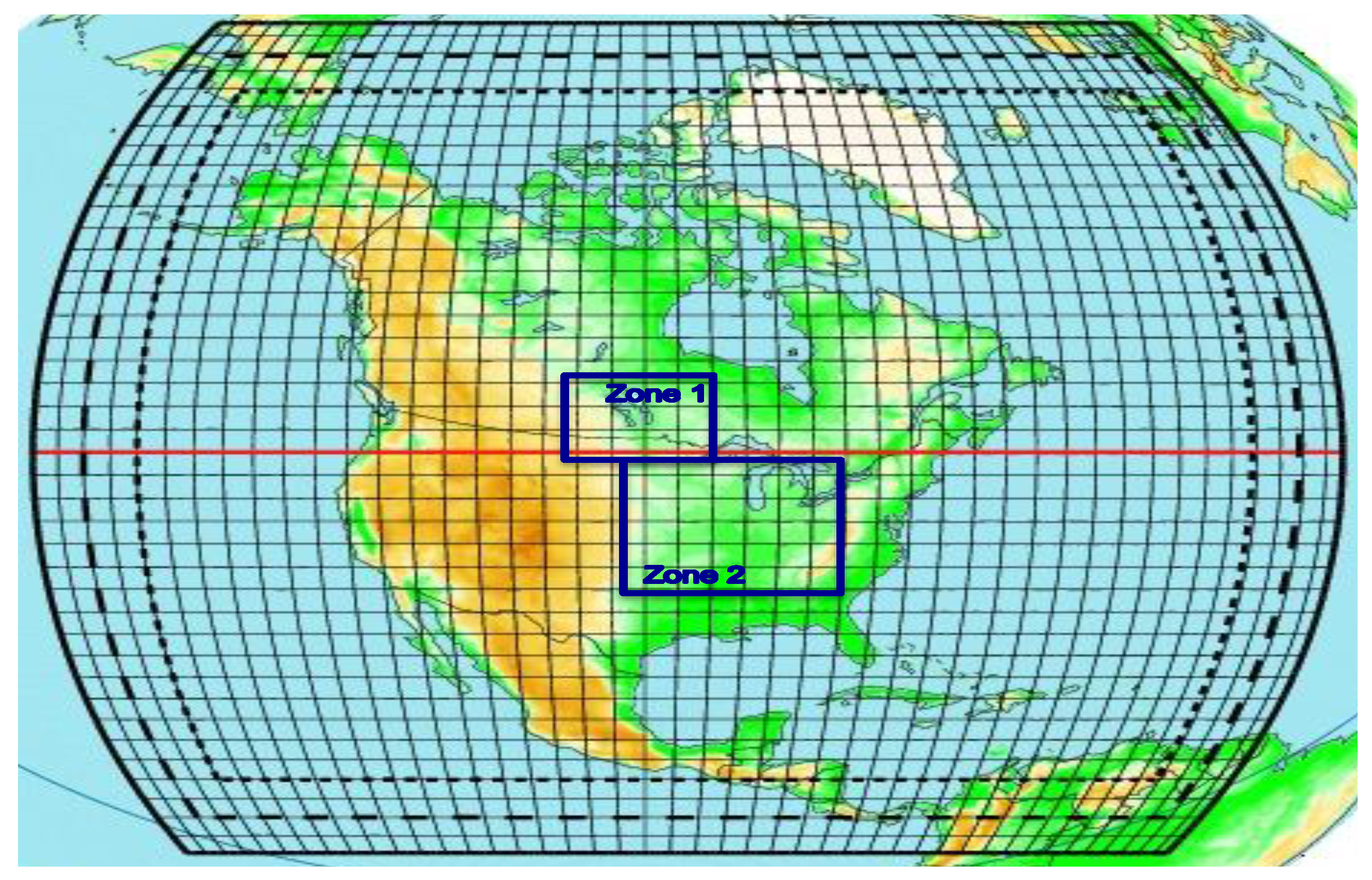
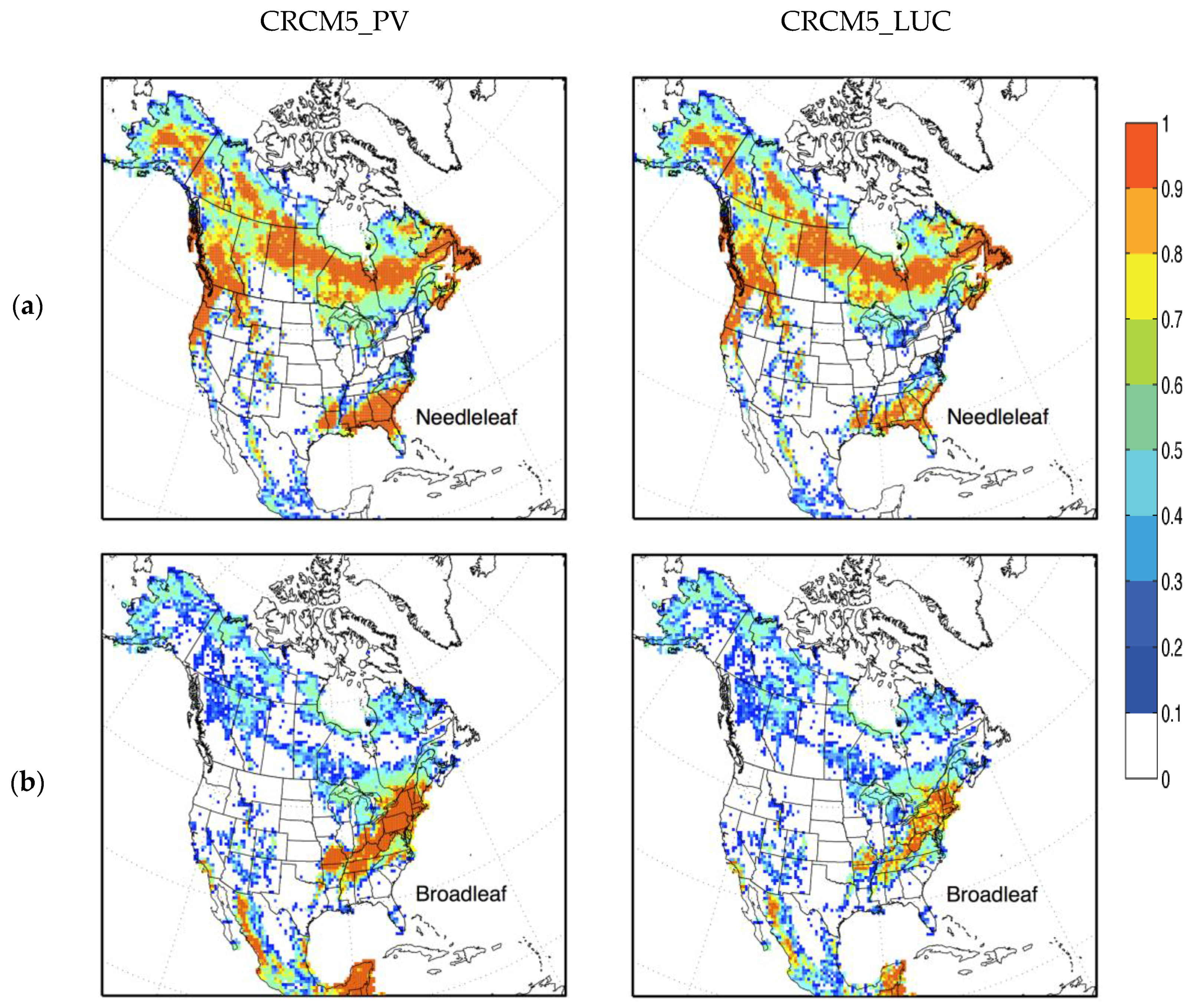
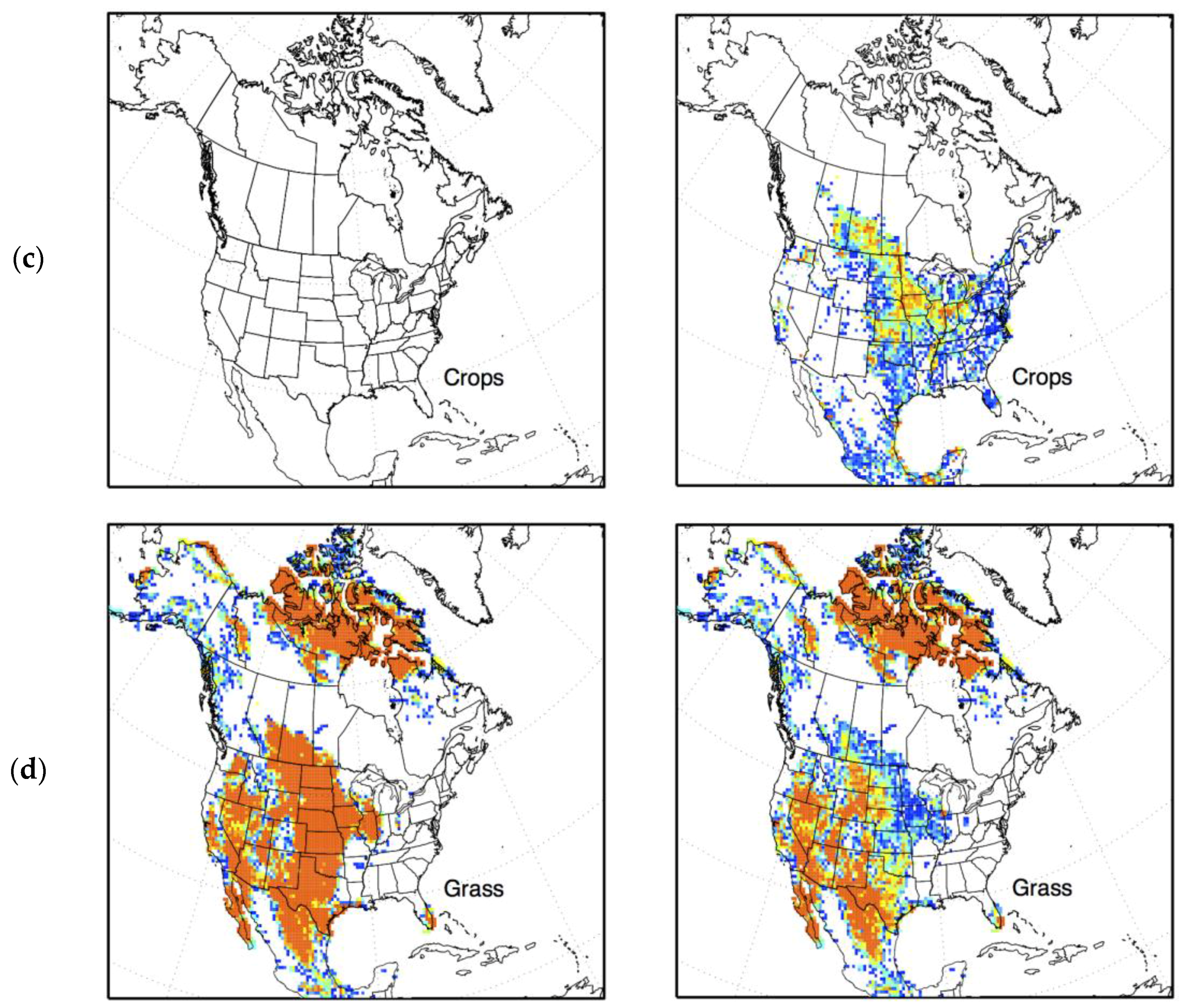
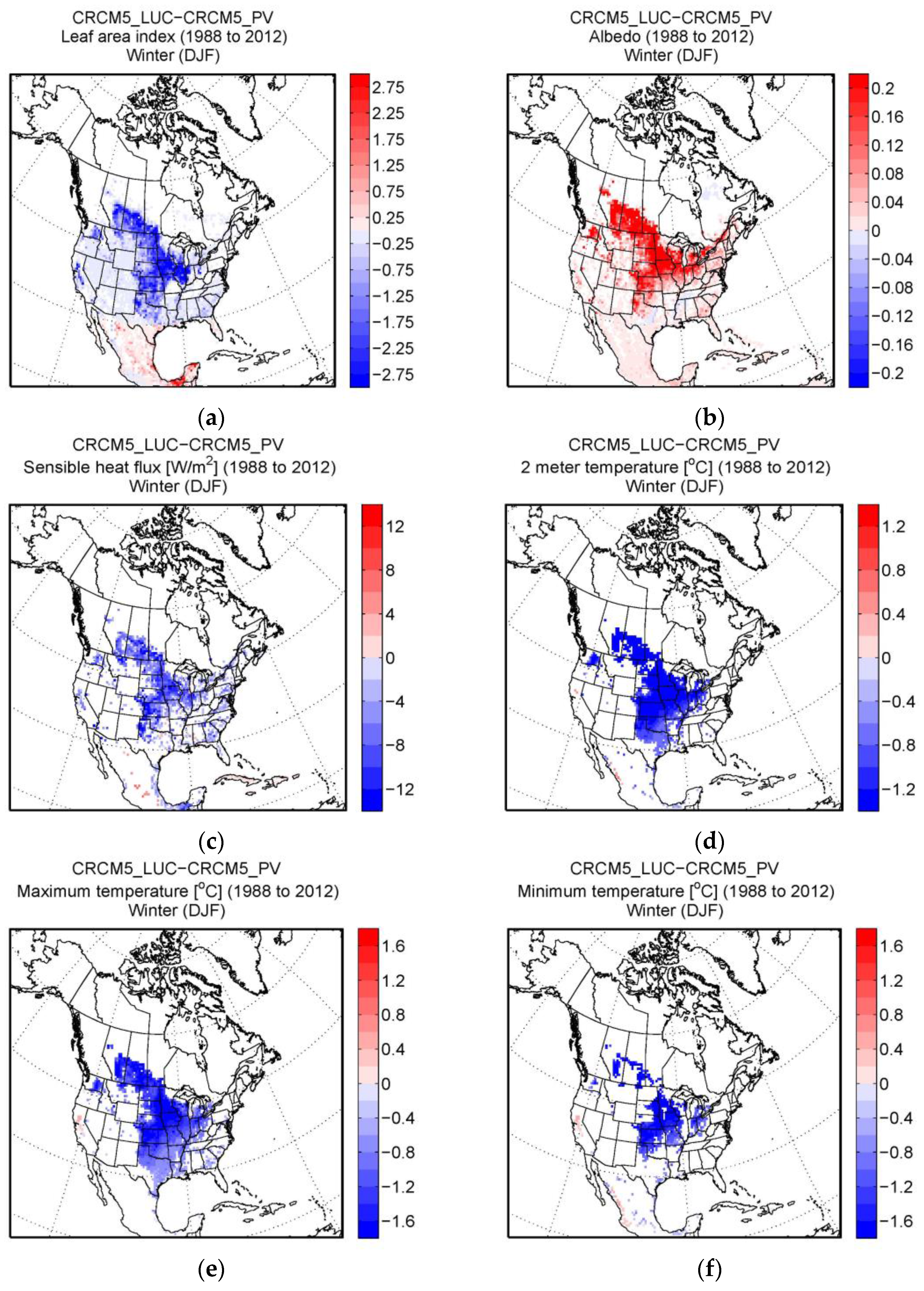
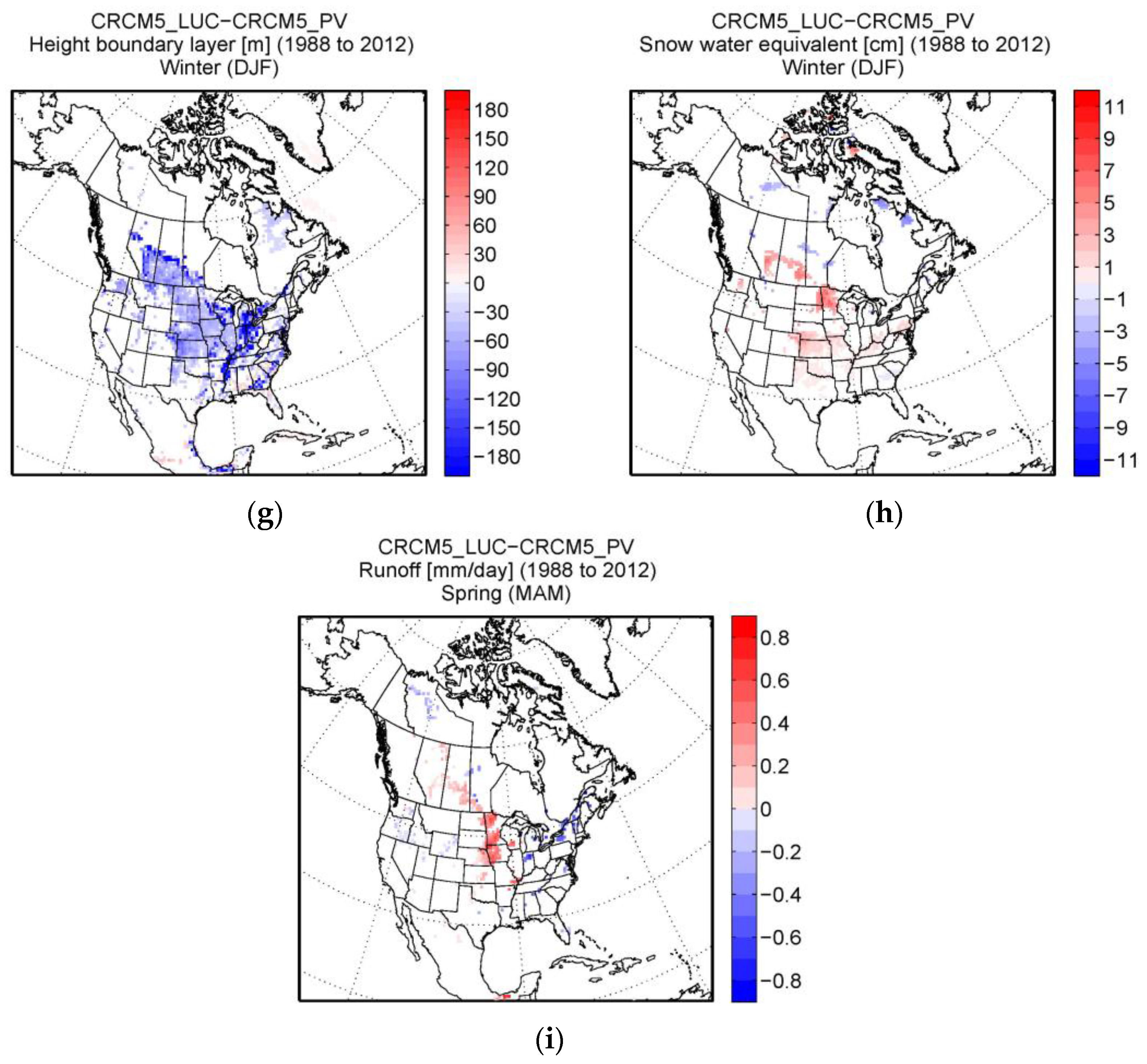
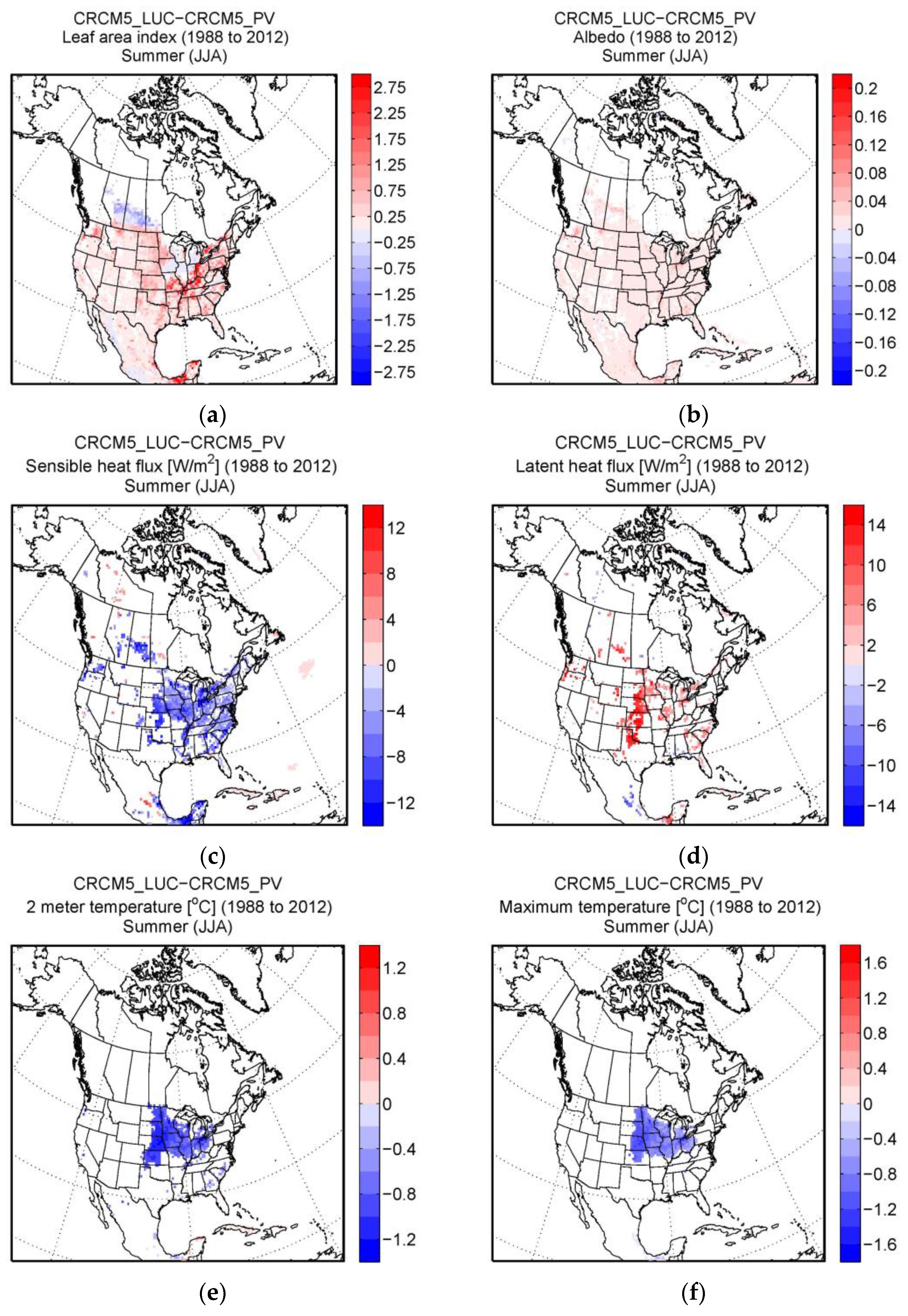
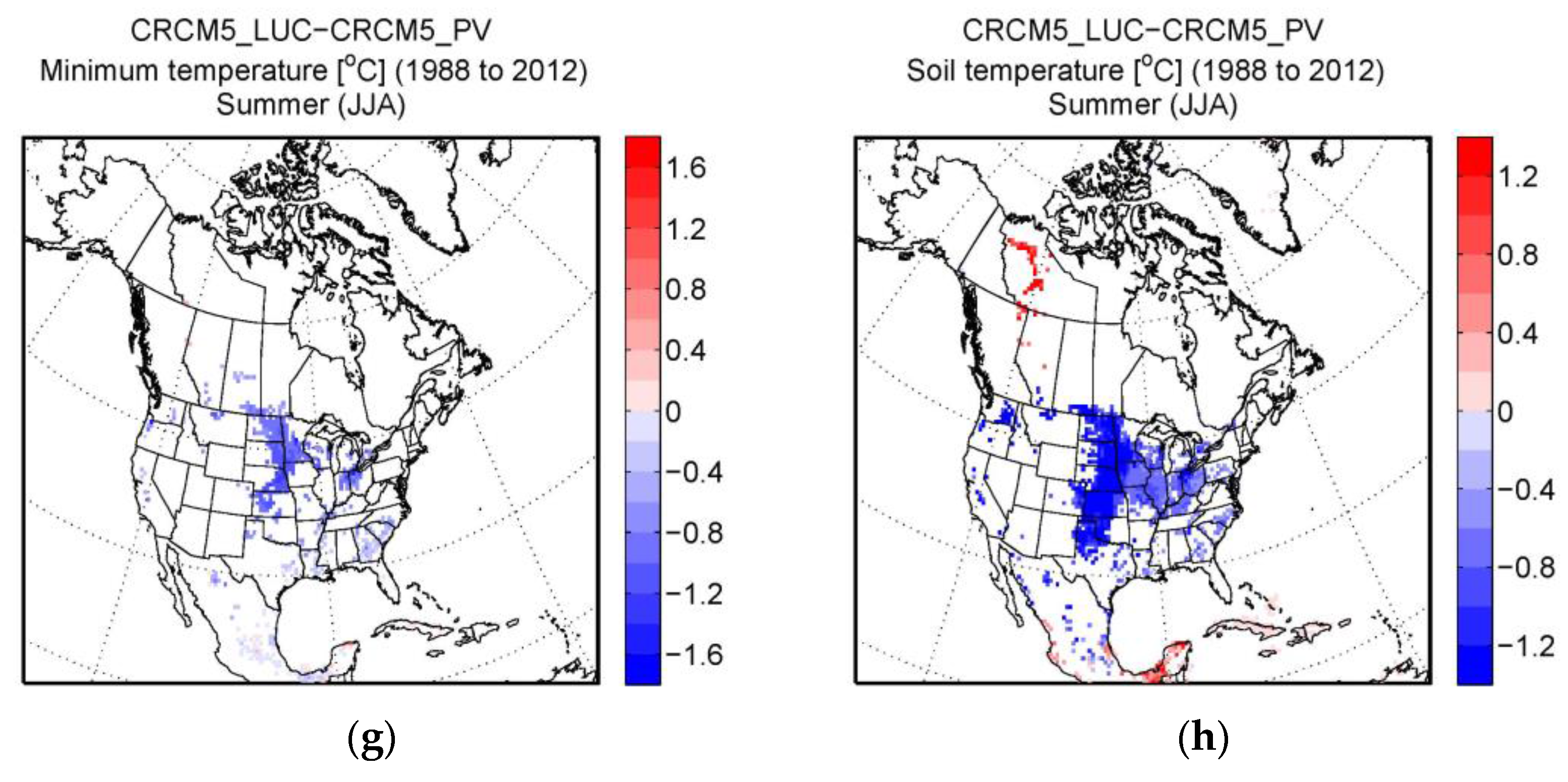
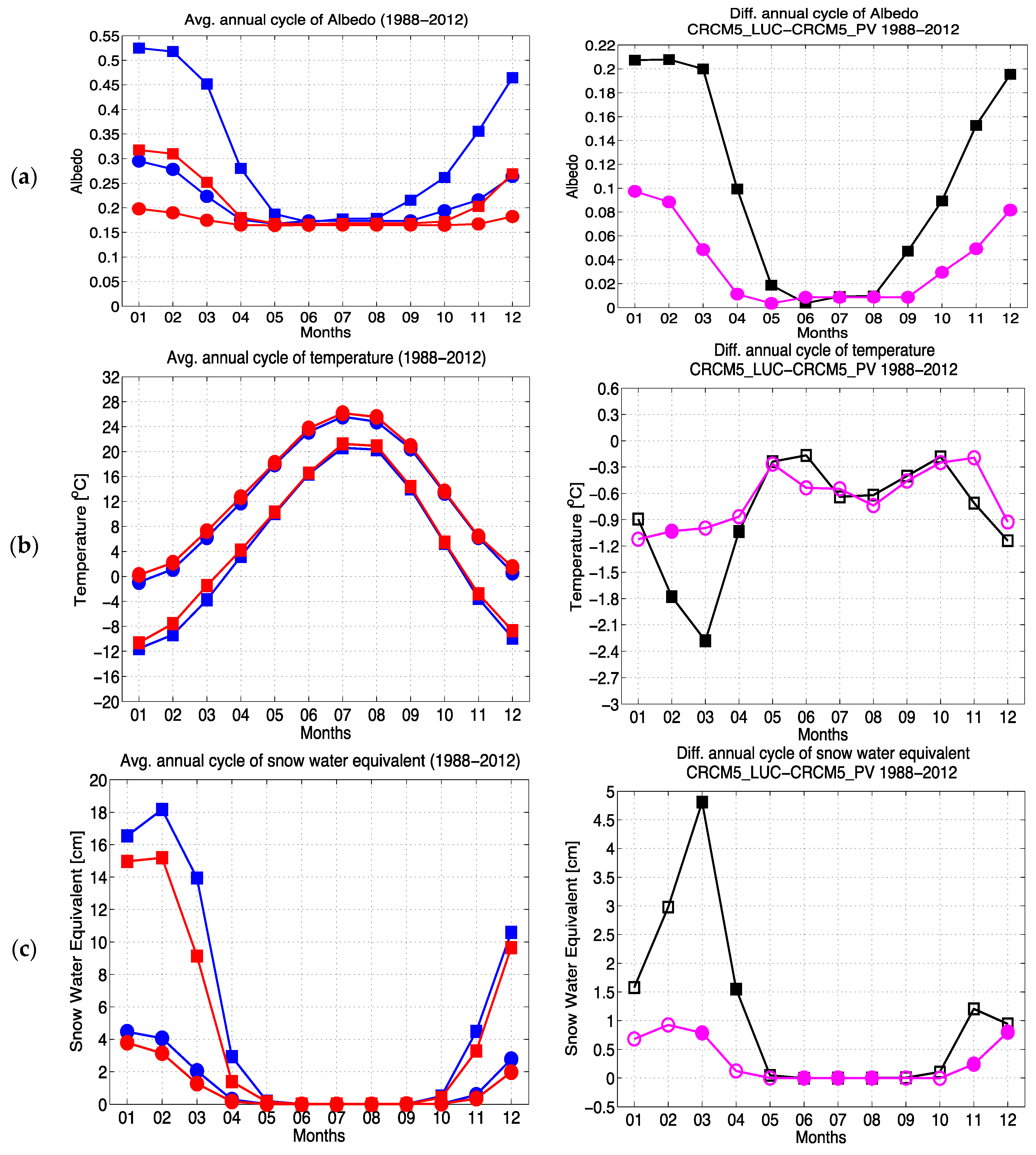

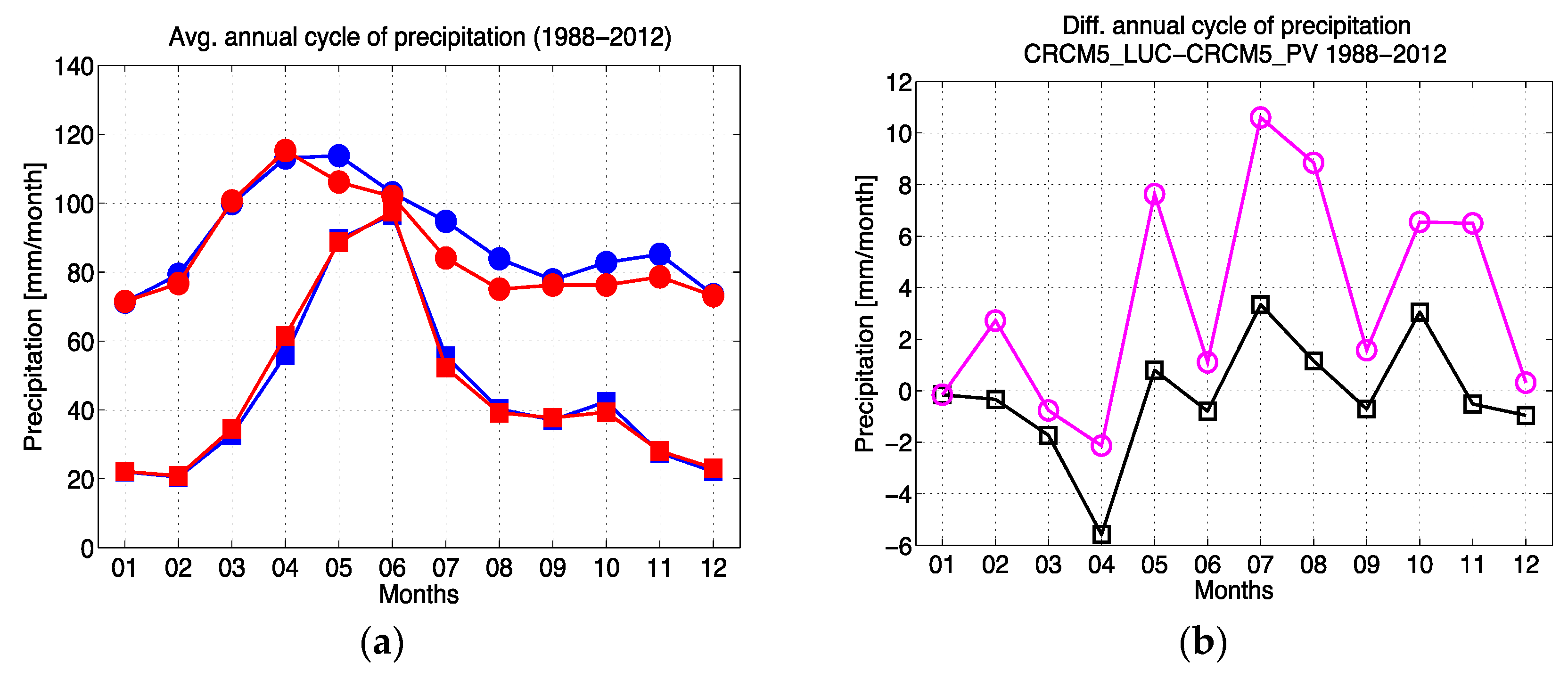
© 2016 by the authors; licensee MDPI, Basel, Switzerland. This article is an open access article distributed under the terms and conditions of the Creative Commons by Attribution (CC-BY) license (http://creativecommons.org/licenses/by/4.0/).
Share and Cite
Chacón, A.; Sushama, L.; Beltrami, H. Biophysical Impacts of Land Use Change over North America as Simulated by the Canadian Regional Climate Model. Atmosphere 2016, 7, 34. https://doi.org/10.3390/atmos7030034
Chacón A, Sushama L, Beltrami H. Biophysical Impacts of Land Use Change over North America as Simulated by the Canadian Regional Climate Model. Atmosphere. 2016; 7(3):34. https://doi.org/10.3390/atmos7030034
Chicago/Turabian StyleChacón, Arlette, Laxmi Sushama, and Hugo Beltrami. 2016. "Biophysical Impacts of Land Use Change over North America as Simulated by the Canadian Regional Climate Model" Atmosphere 7, no. 3: 34. https://doi.org/10.3390/atmos7030034
APA StyleChacón, A., Sushama, L., & Beltrami, H. (2016). Biophysical Impacts of Land Use Change over North America as Simulated by the Canadian Regional Climate Model. Atmosphere, 7(3), 34. https://doi.org/10.3390/atmos7030034




